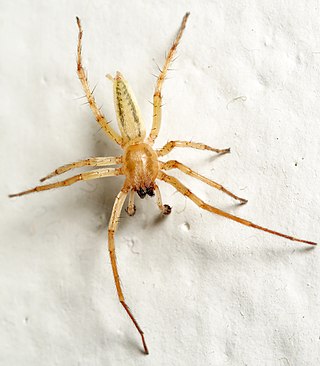
Anyphaenidae is a family of araneomorph spiders, sometimes called anyphaenid sac spiders. They are distinguished from the sac spiders of the family Clubionidae and other spiders by having the abdominal spiracle placed one third to one half of the way anterior to the spinnerets toward the epigastric furrow on the underside of the abdomen. In most spiders the spiracle is just anterior to the spinnerets. Like clubionids, anyphaenids have eight eyes arranged in two rows, conical anterior spinnerets and are wandering predators that build silken retreats, or sacs, usually on plant terminals, between leaves, under bark or under rocks. There are more than 600 species in over 50 genera worldwide.
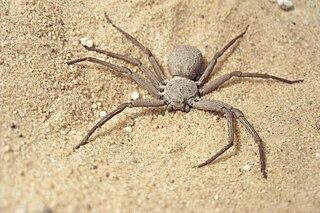
Sicarius is a genus of recluse spiders that is potentially medically significant to humans. It is one of three genera in its family, all venomous spiders known for a bite that can induce loxoscelism. They live in deserts and arid regions of the Neotropics, and females use a mixture of sand and silk when producing egg sacs. The name is Latin for assassin.
Monapia is a genus of South American anyphaenid sac spiders first described by Eugène Simon in 1897.

Acanthogonatus is a genus of South American mygalomorph spiders in the family Pycnothelidae. It was first described by Ferdinand Anton Franz Karsch in 1880. Originally placed with the brushed trapdoor spiders, it was transferred to the funnel-web trapdoor spiders in 1985, then to the Pycnothelidae in 2020.
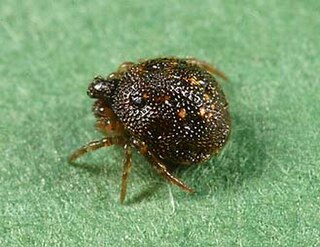
Phoroncidia is a genus of comb-footed spiders that was first described by J. O. Westwood in 1835.
Calacadia is a genus of South American intertidal spiders first described by H. Exline in 1960.
Gayenna is a genus of anyphaenid sac spiders first described by H. Nicolet in 1849.
Oxysoma is a genus of South American anyphaenid sac spiders first described by H. Nicolet in 1849.
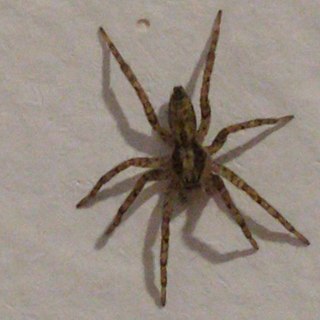
Tomopisthes is a genus of South American anyphaenid sac spiders first described by Eugène Simon in 1884.
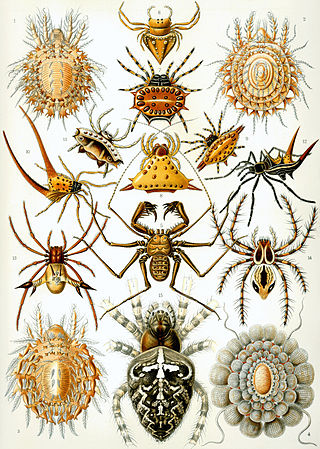
Gnolus is a genus of South American orb-weaver spiders that was first described by Eugène Louis Simon in 1879. Originally placed with the orb-weaving spiders, it was transferred to the pirate spiders in 1993, but moved back to orb-weaver family in 2012.
Diphya is a genus of long-jawed orb-weavers that was first described by H. Nicolet in 1849. D. tanasevitchi and D. albulum were transferred from Lophomma in 2007.
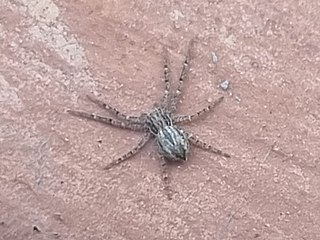
Petrichus is a genus of South American running crab spiders that was first described by Eugène Louis Simon in 1886.

Kochiura is a genus of comb-footed spiders that was first described by Allan Frost Archer in 1950.
Coenypha is a genus of South American crab spiders that was first described by Eugène Louis Simon in 1895.
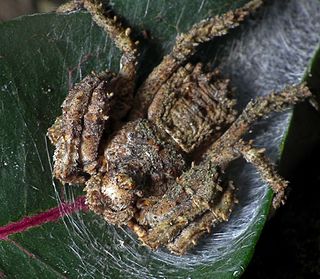
Stephanopis is a genus of crab spiders first described by Octavius Pickard-Cambridge in 1869. It was erected for five then newly described species, including S. altifrons, from Australia. Stephanopis was characterized by the high cephalic region with unequally sized anterior eyes disposed in a strongly recurved row, opisthosoma ending in several spiniform projections and dorsoventrally depressed habitus. According to Pickard-Cambridge, the single specimen used for the description of S. altifrons was dry-pinned. Therefore the specimen could not be properly examined, so it was not possible to determine if the specimen was adult. Moreover, he states his own sketch of the spider as “hasty” or "dull". This may explain why the somatic characters were inadequately described, genitalic features were not mentioned at all, and the illustrations were not detailed enough, making the species unidentifiable.
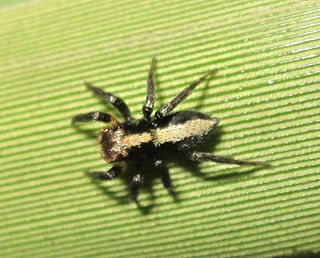
Saphrys is a genus of spiders in the family Salticidae. It was first described in 2015 by Zhang & Maddison. As of 2017, it contains 9 species.
Platnickia elegans is a species of spiders in the family Zodariidae. It is found in Chile and Argentina.

Allende is a genus of South American long-jawed orb-weavers that was first described by F. Álvarez-Padilla in 2007.
Selkirkiella is a genus of South American comb-footed spiders that was first described by Lucien Berland in 1924. Originally placed with the Araneidae, it was transferred to the comb-footed spiders in 1972.
Gasteracantha flava is a species of spider described in 1849 from Chile. The spider's abdomen bears 14 spines and is yellow in color with brown or black sigilla and a strongly wrinkled ventral side. The World Spider Catalog currently treats this taxon as a spiny orb-weaver spider in the genus Gasteracantha. In 1849, H. Nicolet included it in the genus Gasteracantha along with 18 other species he described from Chile. Nicolet described G. flava as being closely allied to another species described at the same time, Gasteracantha spissa, which had the same number and shape of spines and was very similar. Subsequent authors refined Nicolet's species, and in a 1996 publication Herbert Levi wrote, "All Nicolet's species seem to belong in Phoroncidia (Theridiidae)." Levi transferred the 14-spined taxon spissa, described by Nicolet as very similar to G. flava, to the genus Phoroncidia, creating the new combination Phoroncidia spissa. However, Levi did not explicitly address G. flava, so it remains in Gasteracantha as of November 2019, though its purported sister species now belongs to Phoroncidia and no other Gasteracantha species has more than six spines.










